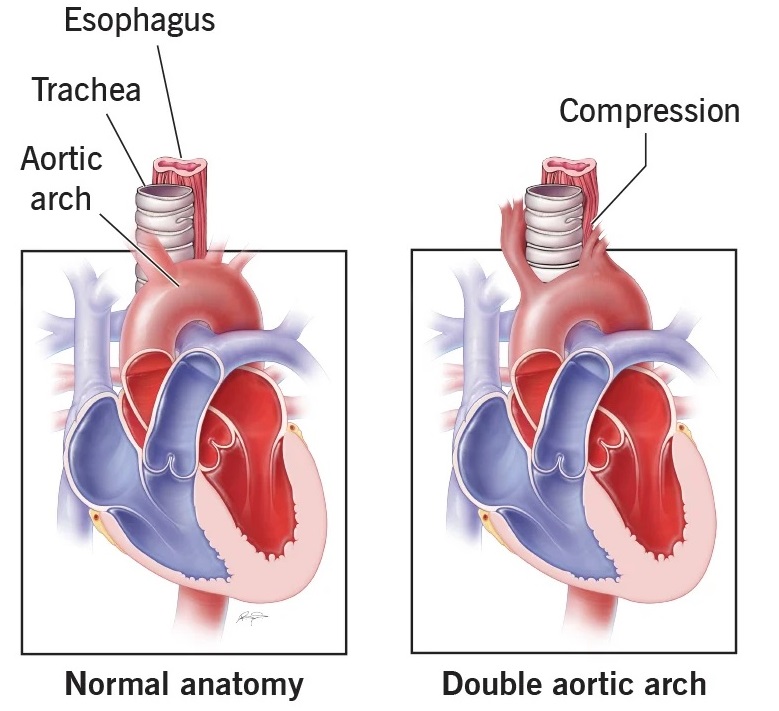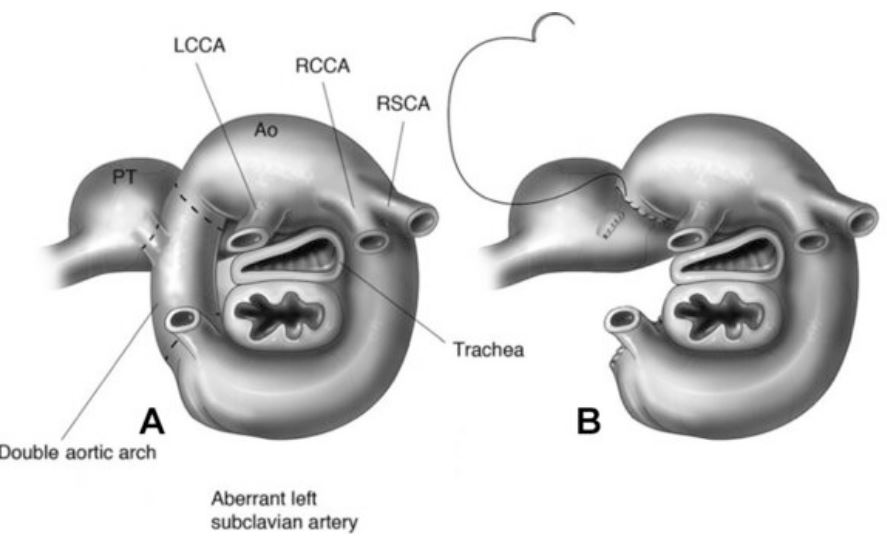What is a Vascular Ring?
A Vascular ring results from an anomalous arrangement of blood vessels, the aortic arch, and its branching vessels, causing compression of the trachea and esophagus and leading to breathing and swallowing difficulties. This condition can cause significant challenges for both children and adults alike.
Symptoms of Vascular Ring
The severity of vascular ring symptoms can vary. In some cases, symptoms may not appear until later in childhood or even adulthood. Common symptoms include:
- Difficulty breathing
- Wheezing
- Noisy breathing
- Recurrent respiratory infections
- Difficulty swallowing
- Choking
Types of Vascular Ring
Vascular rings are a medical condition that can have multiple origins. The most common causes of this condition include the double aortic arch, right aortic arch, and aberrant right subclavian artery.
Double aortic arch: the aorta begins by branching into two arches, which then surround and compress the trachea and esophagus of the infant. The arches subsequently merge back into a single blood vessel on the other side.

Right aortic arch: the aorta takes an abnormal route to the right of the infant’s trachea instead of its typical location on the left. This malformation leads to a normal blood vessel that branches abnormally and moves behind the esophagus. The branch then connects to an artery that supplies blood to the infant’s left arm (left subclavian artery). The ligamentum arteriosum, a blood vessel that remains open during fetal development, completes the ring. These blood vessels can then constrict the infant’s trachea and/or esophagus.
Aberrant right subclavian artery: the artery grows directly from the aortic arch instead of branching from the brachiocephalic trunk. This form of vascular ring is incomplete and may not produce any symptoms.
Diagnosis
Healthcare professionals diagnose vascular rings through physical examination and imaging tests such as echocardiogram (heart ultrasound), X-rays, CT scans, or MRI scans. These tests help to identify the extent of the condition so that proper treatment can be administered. A chest X-ray is a simple and logical starting point for the imaging algorithm. It provides information regarding not only the position of the aortic arch but also the pulmonary complications of the anomaly. Healthcare professionals always indicate an echocardiogram with aortic arch anomalies to exclude any associated intracardiac anomaly. It can locate the aortic arch’s position and its branching pattern. The left aortic arch is the typical pattern. The right aortic arch is associated with congenital cardiac defects. Double aortic arch is rare but causes the most symptoms, and almost all require surgery.
Treatment
Healthcare professionals treat vascular rings depending on the severity and nature of the condition. Some patients may require only medication, while others may require surgery. In some cases, a combination of both may be necessary. The primary goal of treatment is to alleviate the symptoms and improve the quality of life for the patient.
It is important to note that parents of children suspected to have vascular rings should seek prompt medical attention from healthcare professionals for accurate diagnosis and appropriate treatment. Early intervention is critical to preventing complications and improving outcomes.
In conclusion, vascular ring results from an anomalous arrangement of blood vessels that can cause significant challenges to breathing and swallowing. The severity of vascular ring symptoms can vary, and early intervention is critical in preventing complications and improving outcomes. Thus, parents and caregivers should be aware of the signs and symptoms of vascular rings and seek prompt medical attention if they suspect their child may be affected. With proper diagnosis and treatment, healthcare professionals can help patients with vascular rings lead healthy and fulfilling lives.
For cardiac evaluation or cardiac screening, don’t hesitate to get in touch with our clinic at (406)272-2376 or schedule an appointment



